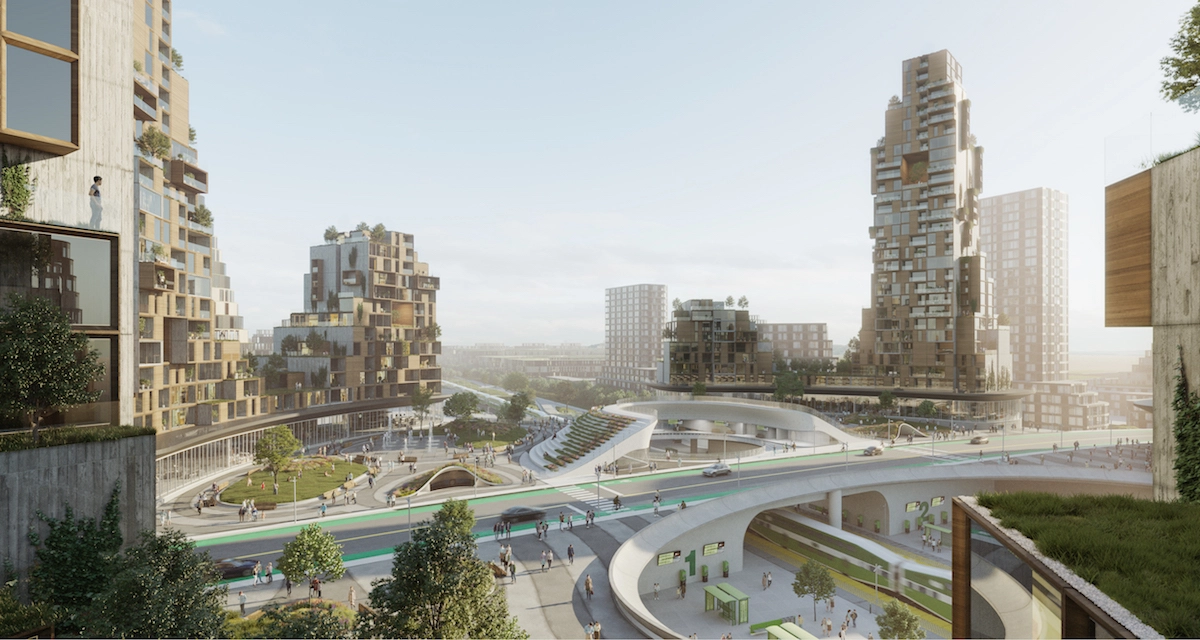Newcastle Cathedral has experienced a transformation beyond the imagination of its medieval constructors. This Gothic architectural wonder features a distinctive lantern spire which has stood over the city since the fourteenth century and now stands as the first historic religious building to achieve complete carbon neutrality.
The cathedral’s leaders discovered through quiet reflection that environmental stewardship required practical measures beyond the typical Sunday environmental teachings. The initiative needed to respect the building’s seven-century-old sacred mission while taking significant steps to combat climate change effectively.
The transformation of the cathedral stands for much more than it’s modern green technology installations within its historic walls. This philosophy demonstrates that there is no conflict between maintaining historical heritage and safeguarding future generations while simultaneously respecting tradition and welcoming new advancements. This project serves as a global model for religious institutions because it illustrates how buildings with deep historical roots can adapt to modern environmental needs while maintaining their core character and spiritual purpose.
The pursuit of environmental innovation intersects with the effort to preserve historic structures.
The cathedral chapter navigated through intricate obstacles while initiating their carbon neutrality journey in the early 2010s that would have discouraged organisations with less determination. The building itself presented numerous obstacles: Thick stone walls made insulation extremely challenging while medieval heating systems proved woefully inefficient and strict heritage protection laws restricted structural modifications. The cathedral received Grade I listing due to its exceptional architectural and historic value which necessitated all proposed changes to involve negotiations with heritage authorities.
The cathedral’s energy consumption was staggering. The large stone building which originated from a time without fuel expenses and environmental concerns needed substantial energy to maintain warmth through Newcastle’s severe winter months. The building’s heating system consisted of layers of modifications and additions from various decades which led to excessive fossil fuel consumption. Powering the organ along with other electrical systems and keeping large interior spaces lit while maintaining comfortable temperatures for people created an energy demand that appeared to conflict with achievable carbon neutrality goals.
Dean Christopher Dalliston’s leadership team along with their progressive chapter acknowledged that their role as guardians of the sacred space went past just taking care of the building’s structure. True stewardship demanded that they preserve the building for future generations while also protecting the habitable planet they would need to enjoy it.
The initial feasibility studies were sobering. The experts advised that the building needed breakthrough innovations and significant financial resources to reach carbon neutrality. The cathedral rejected the usual energy-saving approaches for historic buildings because they required unsuitable compromises. The installation of dense insulation materials would change the building’s acoustic characteristics which could harm its famous musical heritage. Heritage authorities would reject any structural modifications necessary for modern heating systems. The installation of solar panels on the roof would create a visible alteration from the ground which could compromise the historic look of the building.
The cathedral team transformed their perceived limitations into design challenges that needed innovative solutions. The cathedral team built a multidisciplinary group that included architects, engineers, historians and environmental specialists to work towards carbon neutrality while preserving the historical character of the building. The project’s ultimate success depended on the implementation of this collaborative approach.
Solar-Charged Bells: Innovation in the Bell Tower
The cathedral’s transition to carbon-neutral status features no more striking innovation than the solar-powered mechanism that operates the eight-bell peal in the lantern tower. The bronze bells of Newcastle Cathedral have summoned worshippers to its services for generations while their resonant sounds spread over the Tyne Valley to mark both everyday services and special events. The task of preserving this time-honored tradition needed a solution that reduced carbon emissions from the bell mechanisms while remaining technically advanced and respectful to the heritage.
Newcastle Cathedral’s traditional bell-ringing system depended on electric motors to help bell-ringers operate the heavier bells in the peal. The electric motors needed for safe bell ringing required substantial electricity from the power grid. The cathedral kept its bell-ringing tradition alive through a committed group of ringers who practiced weekly and played during services and special events. All proposed solutions must maintain both the acoustic quality and timing of the bells while preserving the physical activity of ringing them.
The engineering team created a new solar collection system that matches the distinct architectural features of the cathedral’s lantern tower. The solar system was designed to attach small photovoltaic cells across the medieval stonework of the tower which remained hidden from ground view, differing from conventional systems that need large flat areas. Maintenance walkways on the tower housed the solar cells which were installed to collect sunlight throughout the day without being visible to the public.
Within the tower structure resides a complex battery storage system that receives energy from the solar collection system. The chosen batteries demonstrate long life and eco-friendly properties while providing sufficient stored energy to run bell-ringing motors for normal operation weeks during Newcastle’s frequently cloudy winter months. Intelligent power management software monitors energy consumption and weather forecasts while tracking ringing schedules to optimize battery charging and maintain constant power availability.
The installation demanded high levels of precision and meticulous attention to detail. Technicians carefully placed and fastened each solar cell to ensure neither the medieval stonework got damaged nor the tower’s structural integrity changed. Designers installed the battery storage system in the tower’s pre-existing spaces which had once contained outdated equipment and other unused areas. Technicians routed all wiring through pre-existing conduits and discreetly hid them in the stonework to maintain the tower’s original appearance.
Renewable energy powers the bell-ringing system which retains every traditional feature that makes Newcastle Cathedral’s bells uniquely recognizable. According to the ringers the solar-powered motors deliver more dependable assistance than the old grid-connected system because intelligent power management delivers optimal performance even when external power changes occur. Despite the bells being powered by green technology their sound remains exactly the same as it always has been.
The cathedral’s dedication to environmental protection is represented through its solar-charged bell system. People visiting express great surprise when they discover that solar energy powers the ancient bells that call them to worship demonstrating that renewable energy can support traditional religious practices. The system operates with exceptional reliability while backup grid connections exist yet remain seldom utilized.
The bell tower solar installation’s success offered crucial insights for other elements of the cathedral’s journey toward a carbon-neutral status. The project showed how renewable energy installations could fit into historic buildings while maintaining both their look and purpose and developed working protocols with heritage authorities which became crucial for later project phases.
Rainwater Harvesting: Ancient Wisdom Meets Modern Technology
The cathedral’s water management strategy stands as the most creative element of its carbon-neutral transformation by blending medieval architectural elements with modern environmental technology to develop a system that would astonish the original builders. The Newcastle Cathedral rainwater harvesting system reduces environmental harm while providing a sustainable answer to the substantial water requirements of maintaining this large complex building.
The cathedral’s medieval designers integrated an intricate system of stone-carved gutters and drainage channels to manage the abundant rainfall typical of Newcastle’s climate. The original features meant to protect the cathedral from water damage were transformed into a modern rainwater collection and treatment system which now supplies most of the cathedral’s water requirements.
The cathedral’s large catchment area for rainwater collection extends across the nave, chancel, transepts and multiple chapels. The medieval lead roof has been conserved throughout history to funnel rainwater into the historic gutter system which now directs the water into modern collection tanks instead of flowing into storm drains. The project needed thorough discussions with heritage authorities to keep visual changes minimal and maintain the building’s original drainage systems.
During a major restoration project, workers built and buried a series of storage tanks for collected rainwater beneath the cathedral’s grounds. The storage tanks, which together hold more than fifty thousand gallons of water, are built from eco-friendly substances and engineered to fit perfectly into the cathedral’s existing foundations and subterranean utilities. Archaeological supervision became necessary for the excavation work because the cathedral’s surroundings contain numerous medieval artifacts and structural remnants from previous constructions.
This rainwater treatment system exemplifies modern environmental engineering expertise which has been tailored to meet the special needs of a historic building. Water treatment at the cathedral begins with basic screening to remove leaves and debris and advances through sedimentation tanks where particles settle before reaching advanced filtration systems which produce versatile water for multiple cathedral functions.
The rainwater that has been processed supports multiple operational needs within the cathedral. The building’s restroom facilities receive water from this system which lessens municipal water system use while also removing the carbon footprint from water treatment and delivery. The system directs water toward cleaning the cathedral’s expansive stone areas which demands thousands of gallons each year to preserve both the appearance and structural soundness of the building. Rainwater is ideal for cleaning historic stone surfaces because its lack of minerals and chemicals avoids leaving residues and prevents chemical weathering.
The primary advantage of the rainwater harvesting system is its ability to provide water for the cathedral’s heating system which operates through radiant heating elements installed in the nave floor and other essential areas. The heating system provides comfortable worship space temperatures with minimized energy use through its closed-loop circulation system which needs a steady water supply. The heating system reaches its maximum performance when harvested rainwater supplies the necessary water while avoiding costly expenses and environmental harm.
Rainwater harvesting system provides water for the cathedral’s gardens and landscaped areas. The cathedral grounds which feature memorial gardens, pathways and green spaces serving as a peaceful city retreat are irrigated exclusively with harvested rainwater. The system both minimises environmental effects of upkeep while keeping gardens beautiful throughout droughts and water shortages.
Bee-Friendly Rooftops: Biodiversity Above the Sacred Space
The rooftops of Newcastle Cathedral stand above worshippers and visitors as thriving ecosystems which support local biodiversity while helping the building achieve its environmental sustainability objectives. The cathedral’s carbon-neutral transformation includes a bee-friendly rooftop initiative which stands as one of the most innovative ecological components by providing habitats for pollinators and wildlife in densely populated urban England.
The idea to use the cathedral’s vast roof spaces for ecological functions developed through conversations about enhancing the building’s carbon-neutral transformation environmental benefits. Although the main roof surfaces had to stay clear for rainwater collection and solar power generation, the cathedral had smaller roof spaces above chapels and administrative areas which could serve as innovative sites for ecological projects that would help wildlife and strengthen its environmental standing.
The cathedral’s unique architectural challenges and urban setting demanded careful planning when designing bee-friendly rooftop spaces. The rooftop plant communities must endure Newcastle’s high-altitude climate conditions while supplying necessary resources for the local bee populations throughout their yearly lifecycle. The rooftop plants needed to be light to protect medieval roofs while also featuring drought resistance and wind/weather endurance for rooftop settings.
The cathedral created a detailed planting scheme that focuses on native plants beneficial to local bees through collaboration with regional ecologists and beekeeping specialists. The rooftop gardens showcase a meticulously chosen combination of wildflowers, herbs, and small shrubs which deliver continuous sources of nectar and pollen during the entire growing season. Bees breaking out of winter dormancy gain vital sustenance from early-blooming species like crocuses and snowdrops whereas late-season plants like asters and sedums prolong their foraging period until late autumn.
The rooftop gardens utilize a unique lightweight growing substrate specifically developed to deliver optimal drainage yet maintain sufficient moisture for plant growth during dry spells. The planting substrate which utilizes recycled materials mixed with organic compost generates optimal plant growing conditions while maintaining minimal load on the roof structures. Different rooftop areas have varying depths of growing medium where deeper sections sustain large plants while shallower sections enable the growth of ground-covering species and wildflowers.
The bee-friendly rooftops consist of different zones specially designed to sustain various elements of bee ecology. Wildflower meadows planted in sunny open spaces generate plentiful foraging resources during the peak growing season. Solitary bees find nesting sites in sheltered areas with tall plants and small shrubs and specially made bee hotels create additional nesting spaces where natural places are scarce. The bee hotels made from natural materials such as bamboo wood and clay offer necessary nesting sites for native bees and match the historic cathedral architecture perfectly.
The rooftop gardens’ water features deliver drinking water for bees and pollinators alongside enhancing the rooftop ecosystems’ health. Rainwater harvesting systems supply water to features of varying depths which form microclimates that nurture greater biodiversity among plants and animals. The water features include gentle slopes and landing areas that enable bees and other small insects to drink without drowning.
The cathedral’s specially designed rooftops now serve as a diverse habitat for multiple bee species including some rare and declining populations found in urban areas. Naturalists have recorded more than thirty distinct bee species using rooftop habitats which support social groups such as bumblebees and solitary bees nesting in specialized features. Besides bees, the rooftops sustain butterflies, hoverflies and helpful wasps which support urban environmental health.
The bee-friendly rooftop initiative has produced widespread effects extending beyond the cathedral’s immediate area. Rooftop habitats function as movement corridors for pollinators across urban areas by linking expansive green spaces and promoting genetic variation in nearby bee communities. The cathedral’s project inspired other Newcastle institutions to establish pollinator-friendly spaces which together create a network of urban habitats supporting significantly larger populations of bees and other beneficial insects.
The cathedral’s community outreach now includes educational programs focused on its bee-friendly rooftop spaces. Educational visits from school groups focus on pollinator ecology and urban biodiversity while adult learning programs study how environmental stewardship connects to spiritual practices. Visitors can see through the rooftop gardens how human actions can sustain natural ecosystems instead of damaging them which provides inspiration and hope to those worried about environmental issues.
The bee-friendly rooftops are maintained through ecological principles which reduce human interference and support the sustainable health of their planted ecosystems. The gardens use organic management practices that exclude pesticides and synthetic fertilizers while depending on natural processes and precise timing of interventions to sustain plant health and diversity. The timing of seasonal management activities including the removal of spent flower heads and invasive species aims to reduce interference with bee nesting and foraging behaviors.
The cathedral achieves its carbon neutrality aims by utilizing rooftop gardens which help sequester carbon and reduce urban heat island effects. Plants on the site take in atmospheric carbon dioxide which they store in their tissues and the growing medium while green surfaces lower temperatures of the building and nearby areas when it is hot. Though the cathedral’s renewable energy systems deliver more substantial benefits, these contributions still play a significant role in enhancing the building’s environmental performance.
Integration and Synergy: How the Systems Work Together
The real brilliance behind Newcastle Cathedral’s carbon-neutral transformation emerges from combining multiple systems into a sophisticated whole which produces environmental benefits that exceed what each individual system could achieve alone. Visible sustainability features like solar-charged bells and bee-friendly rooftops show only part of the cathedral’s complete strategy to protect the environment through every operational aspect.
The combined systems establish synergistic effects which increase their environmental advantages while lowering both operational costs and maintenance demands. The rainwater harvesting system delivers water to support both the building’s heating system and general functions while providing irrigation for the bee-friendly rooftops when rainfall is scarce. This system integration removes municipal water requirements for maintaining rooftop ecosystems and keeps pollinator habitats productive during the entire growing season.
The solar energy systems include both the prominent bell tower installation and additional low-profile photovoltaic arrays that blend into south-facing roofs as well as building-mounted systems that remain hidden from ground views. The interconnected energy systems produce renewable power that exceeds the cathedral’s annual consumption while the surplus energy is returned to the grid to reduce emissions from different sources. The decentralized arrangement of solar installations secures both redundancy and reliability while optimizing energy production across various times of day and different weather situations.
The cathedral’s energy storage systems establish a microgrid that maintains operational independence from municipal electricity sources when required. This feature became crucial for maintaining essential services during power failures and grid fluctuations since it kept heating, lighting and security systems running under any conditions. The storage systems allow the cathedral to manage its energy use effectively by storing excess renewable energy during periods of high generation and distributing it when demand increases or renewable energy production decreases.
The cathedral’s heating system demonstrates engineering excellence through its combination of traditional and modern methods to achieve superior efficiency while sustaining appropriate comfort levels for worship services and community events. Embedded radiant heating elements in the nave floor and other important locations produce even warmth that naturally rises to maintain occupant comfort while reducing energy usage. Water heated by solar thermal collectors combined with high-efficiency heat pumps powers this system which keeps building temperatures comfortable while the energy use remains much lower than the former heating system.
The cathedral’s environmental systems operate under advanced building management systems which use artificial intelligence and machine learning algorithms to optimize performance by analyzing weather conditions along with occupancy patterns and available energy sources. Through practical learning these systems develop advanced predictive capabilities which allow them to adapt to varying conditions while reducing both energy use and environmental damage.
The cathedral approaches carbon neutrality through comprehensive operational changes beyond traditional energy and water system management. The waste management approach focuses on cutting down waste generation while advocating for recycling and reuse as organic material from ground maintenance and food services undergoes on-site composting to nourish rooftop gardens and surrounding landscaped spaces. The cathedral promotes alternative transportation methods such as public transit and cycling while offering electric vehicle charging powered by their renewable systems for driving visitors and staff.
The organisation’s purchasing guidelines focus on suppliers and products that are environmentally conscious while showing preference for local vendors to reduce transportation emissions and bolster the local economy. The food services at the cathedral focus on organic ingredients sourced locally while the selection of cleaning and maintenance products takes into account environmental qualities and compatibility with historical building materials.
By combining environmental systems with its spiritual mission and community outreach the cathedral creates educational and inspirational opportunities that reach beyond its physical structure. During worship services environmental stewardship and creation care themes are consistently featured while educational programs teach visitors about the links between faith sustainability and social responsibility.
People who explore the relationship between environmental action and spirituality now visit the cathedral as a pilgrimage site because it provides conferences, workshops, and retreats focused on these subjects.
Conclusion
The achievement of Newcastle Cathedral becoming carbon-neutral extends beyond its technical accomplishment and environmental leadership. Through the Newcastle Cathedral transformation we witness a deep revision of how historic preservation interacts with environmental responsibility illustrating that cultural heritage elements can strengthen through aggressive environmental efforts while maintaining coexistence.
The transformation of the cathedral from a major fossil fuel user to a renewable energy producer demonstrates our existing architectural structures’ immense capabilities in climate change mitigation. The Newcastle Cathedral initiative demonstrates how historic buildings can serve as pioneers for sustainability instead of hindering environmental advancements. Developing solutions for the cathedral’s specific challenges led to new environmental possibilities for heritage buildings around the world and the project’s success motivated numerous other organisations to initiate their own environmental changes.
The effective partnership between Newcastle architects with heritage architects became crucial for completing the project successfully and established a novel framework for cooperation across different disciplines in environmental heritage projects. The project succeeded because professionals combined their knowledge of local building traditions with modern environmental technologies and historic preservation methods to create solutions only possible through comprehensive collaboration. This collaborative effort illustrated that sustainable architects can integrate their work into historic settings respectfully while heritage architects can incorporate green innovations without sacrificing their preservation principles.
The combination of solar-powered bells with rainwater collection systems and bee-friendly rooftops marks the initial phase of merging environmental innovation with historical character preservation and spiritual objectives. These interlinked systems generate environmental advantages which go beyond the cathedral boundaries by helping local ecosystems, lessening municipal infrastructure demands and advancing renewable energy usage. This project shows how environmental stewardship and historic preservation work together as dual aspects of responsible custodianship which respects both our cultural heritage and our duty to future generations.
Other institutions looking to implement similar projects will find important insights in the solutions developed during the cathedral’s carbon-neutral transformation process. The complexity of environmental upgrades in historical structures requires patient cooperation between patients and heritage authorities alongside creative funding approaches and extensive community outreach. The cathedral demonstrates that persistent efforts combined with creative solutions and dedication to environmental preservation together with heritage preservation can successfully navigate these challenges.
The cathedral’s transformation impacts policy creation as well as education advancement while broadening public awareness of historic preservation combined with environmental initiatives. The project shaped regulatory policies while inspiring scholarly investigation and establishing sustainable heritage management templates now implemented by worldwide institutions. The cathedral remains a demonstration site and educational resource that generates multiplying benefits from its original environmental investment.
This project’s success has become the standard framework which Newcastle architects and heritage professionals now utilise to address environmental issues within historic buildings. Heritage architects now possess innovative tools for environmental stewardship integration while sustainable architects use a proven model to reach ambitious environmental goals alongside historic preservation.
The Newcastle Cathedral project showcases how institutions can take the lead to tackle today’s environmental challenges through their example. The cathedral demonstrates how religious and cultural organizations can achieve environmental stewardship and enhance their central missions by taking ownership of their environmental impact and investing in exceptional innovations beyond mandatory standards.
The cathedral’s achievement of carbon neutrality demonstrates that even the oldest and most rigid structures can adapt to meet twenty-first century environmental challenges. This achievement demonstrates human creativity together with collective knowledge and dedication to safeguarding history while ensuring future protection.
Main image Photography by: https://unsplash.com/@__doka






